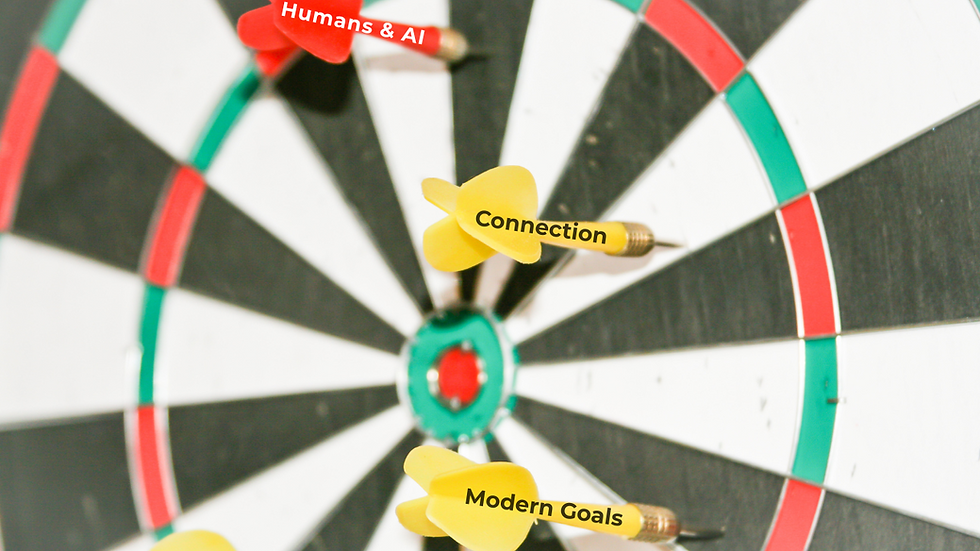How Non-Profits Can Show Businesses How to Humanize Content
- Scott Murray
- Mar 30, 2024
- 7 min read
While helping businesses humanize their content, I've noticed that many non-profit strategies have moved into the for-profit space. It makes sense because non-profit and not-for-profits develop strategies that create humanized messaging that is designed to:
Trigger emotion
Break mental barriers
Inspire confidence in consumer actions (donating, etc.)
Many of the behavioral science characteristics that help non-profits (like social norms, relevance and resonance) can help for-profit companies.
So, if you're a business trying to take your first steps in becoming a more humanized brand that connects with people, non-profits can provide a good starting point.
Here are some of the humanized content philosophies that can now be used by for-profit businesses.
Humanize Content by Activating (The Right) Emotions

When I stepped in to help the Dallas/Forth Worth Public Radio Station improve their on-air fundraising results, they were dealing with many of the same challenges that many NPR stations face.
The biggest one is that listeners HATE fundraising drives. 😠
As such, the station was getting complaints about the never-ending interruptions of what public radio listeners called "beggar radio."
While fundraising is supposed to tap into human emotions, every time a "pledge break" interrupted programming - it often generated negative emotions and responses like:
Part of the problem was that listeners knew what the on-air voices were going say almost every time. They've heard the same "fundraising messages" repeatedly for years.
These all-too-common messages, coupled with word choices like "support us," is what inspired the "beggar radio" label.
It all sounded the same.
Each drive. Each break.
This parallels the experiences of today's B2C and B2B audiences.
They see social media posts, emails and other content using the same language, tones, and word choices over and over again.
It's "corporate."
It's salesy.
It generates the wrong emotions and responses.
There's no surprise, mystery, or differentiation.
Yet the messages suggest people should not care and just respond accordingly.
Instead of changing stations or muting a pledge break, B2B and B2C audiences block, delete and ignore this content.
To make improvements at the station, we:
Made the pledge breaks sound less like interruptions
Changed messaging to sound like they're talking to ONE person listening
Diversified the format of the breaks - adding variety that sounds more like programming
Used language that makes potential donors feel like they are part of a larger impactful effort
Many of these changes work because they break out of the typical ways public radio stations develop pledge breaks.
In for-profit industries, the key is changing the messaging that consumers are used to hearing, seeing and hating and turning it into something that generates mystery, emotion, curiosity, connection and positive response.
Find ways to do this across all content that your audience consumes.
Humanize Content by Talking Like Your Audience

During fundraising drives, it was common for the famous NPR voices to create generic content to help stations fundraise, and nobody did it like Ira Glass.
Aside from being a loved and trusted voice, Ira was transparent and spoke the listener's language.
He was unafraid to make a fundraising pitch while acknowledging that we ALL hated fundraising drives and wished we didn't have them.
He also wouldn't limit his message to just those who regularly gave.
Instead, he asked them to send him the contact information of a friend or family member who always listened but never donated.
He would then record the call so listeners could hear their reasons for listening but not giving.
As I mentioned, Ira is beloved.
So, when he would call a listener and say, "This is Ira Glass," their response would be like:

He would ask them about their listening habits, and most of them were hardcore listeners.
So, he would ask them why they didn't give.
Even though they had "answers," they knew they SHOULD support something they love.
The message resonated with donors, especially those who hadn't donated.
Why?
They heard one of their own talk about it.
Ironically, when I first started working with the station. I was told a listener could hear a powerful or inspiring message... begin to call the station...
And then stop themselves. 🛑
They would think, "Well...of course that message sounds good. You work for the station. You're paid to say that stuff."
It was common for people to prove to themselves that they could resist the station's pitches. It felt good to prove the pitches couldn't "get them."
So, I started to record interviews with people who gave every drive.
I told them to speak freely. I wasn't trying to drive the "right answers."
I asked them why do they listen and give.
I asked why they thought others should give.
While some common themes existed in people's answers, they all had their own ways of expressing their thoughts and feelings.
I would then take their answers and produce content featuring their testimonials.
💥 The barrier created by "you're paid to say that stuff" was broken.
This was a game-changer and inspired listeners to call the station and share how much they loved hearing these stories.
Today's marketers are encouraged to speak like their consumers or audience.
👉🏻 In the for-profit business world, people love to prove that marketing messages can't "get them" to click, read, listen, watch, buy, act, etc.
Your content strategy and messages have to be crafted to break those barriers.
👉🏻 Additionally, we know that customer testimonials are a game-changer for businesses.
But don't just interpret that to mean, "We need client/customer testimonials."
Ask your customers and clients questions that put them at ease and allow them to speak naturally about their thoughts and feelings about your product or service.
If you try to force a specific set of words or a positive message, it will sound unnatural, like you were asking them to read a teleprompter.
Listen to them and remember the language used to describe their challenges, feelings and goals.
Learning that language can help you pick the right words to humanize your content and improve how well you resonate with your audience.
Humanize Content by Inspiring Confidence

I was working at the public radio station when charity fundraising was under some scrutiny. There were controversies surrounding where the money actually went after it was received.
However, experts said people's attitudes about charitable giving were already changing - the controversies just worsened it.
I thought a key way to break cynicism was to be more transparent in our messaging about donations.
We needed to be more specific about the impact donations could have - even "smaller" ones. Here's one way we did it:
I met with the program director about how much it would cost the station to buy specific programs that aired every day.
Then, we broke that cost down by year, month, day, week and hour.
It allowed us to say how much a specific donation helped pay for the community to hear a program. We could tell how one donation could pay for programming - anywhere from an hour to several weeks or months.
It made it easier to visualize the impact while better understanding how donations supported the ability to provide programs for them and their communities.
This transparency also created more meaningful reasons to feel good about giving.
Ten years later, non-profit transparency and other messaging strategies that break consumer cynicism are more critical than ever.
On the for-profit side of things, consumers are looking for transparency in details like pricing and maybe going as far as explaining why something costs what it does (if it's more expensive than the competition).
Humanize Content by Talking to One Person

When making fundraising pitches on the radio, the listener can feel like you're not talking to them.
This can put the ability to connect with them at an immediate disadvantage.
This could start with the talent telling each other good morning and making small talk while the consumer just listens to their conversation.
Then, by broadcasting to the whole community, opportunities are missed to speak to that ONE person who is listening in their car, at home, at work, etc.
Part of my improvement strategy focused on talking to that one person.
On the for-profit side, the concept of talking to one person relates to:
🎙 People who produce podcasts or YouTube videos talking to one viewer or listener instead of everyone who could be watching or listening.
How many videos have you watched where the person on camera opens with, "Hey guys!"
Focused email campaigns that focus their attention on fans, readers, and repeat buyers instead of a mass broadcast email that most people ignore.
🤝🏻 Personalized content
As Entrepreneur points out, people are often more inclined to contribute to causes that resonate deeply with them on a personal level. Without a strong sense of connection or empathy towards the issue, people are likely to consider alternatives.
This is also true in for-profit marketing today. Modern marketing talks about creating:
A sense of belonging
Emotional connections
Personalized content
While considering this, it's worth noting the key differences between personal and personalized content.
Mark Schaefer puts it this way:
Personalized is cut-and-paste
Personal is unique and custom.
Personalized doesn’t require any knowledge of the customer.
Personal reflects an understanding of a human being.
Personalized doesn’t elicit an emotion.
Personal creates an emotional bond that may lead to reciprocity and new business benefits.
When you consider the differences, you can conclude that people today tend to see " personalized " content from marketers who confuse it with personal content.
Personal requires more consumer research, humanized communications in content and a strategy focused on trust and relationship building.
While we've identified ways non-profit messaging can help content marketers, it's worth noting that for-profits aren't the only people needing to evolve their messaging to align with consumer behaviors.
Brian Crimmins, Nathan Chappell and Michael Ashley call those challenges part of The Generosity Crisis, and they have identified several ways to address it.
However, for-profit businesses have been experiencing a humanization and connection crisis for several years, and they could learn from successful non-profits to improve their situation.
If I can help evolve your non-profit or for-profit messaging, you can contact me here or email me Scott@ScottMurrayOnline.com.




Comments